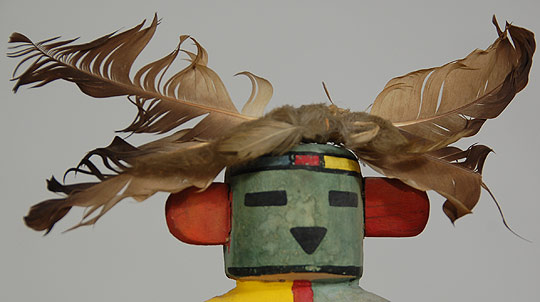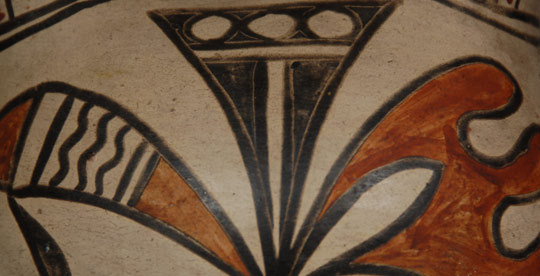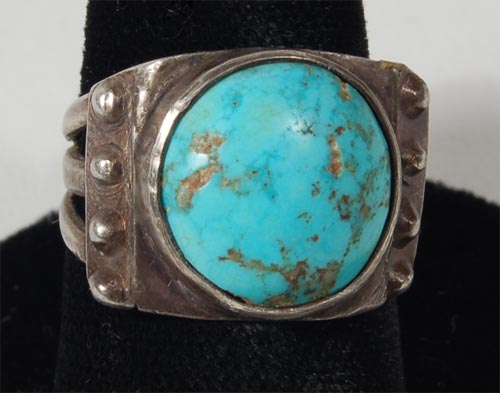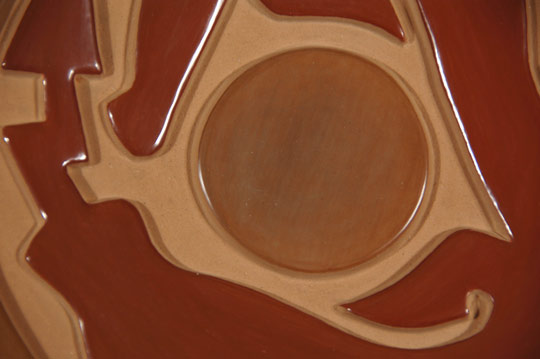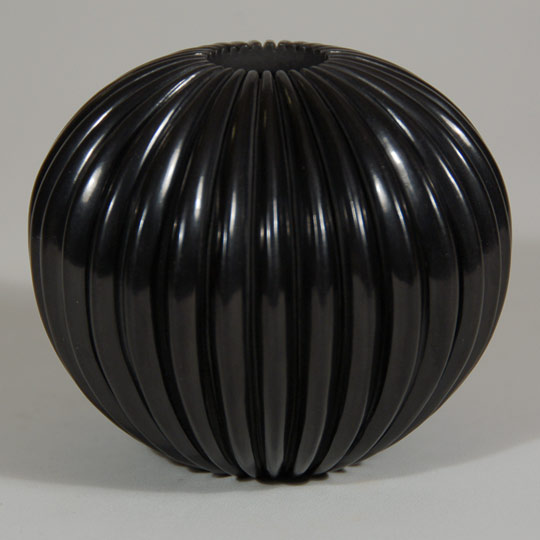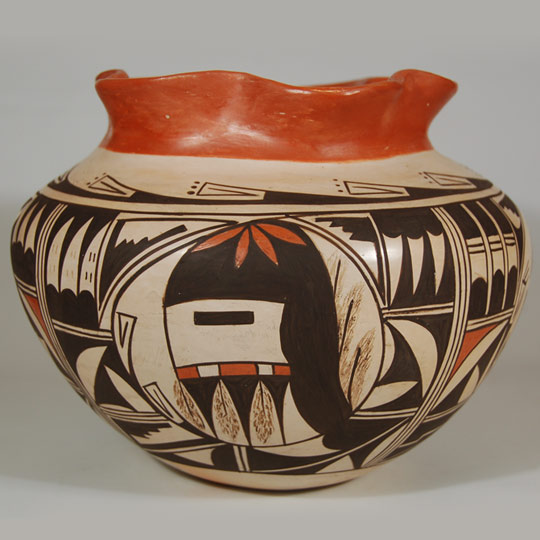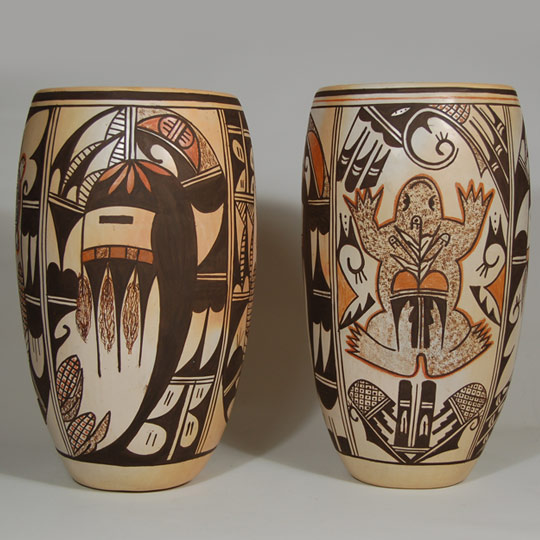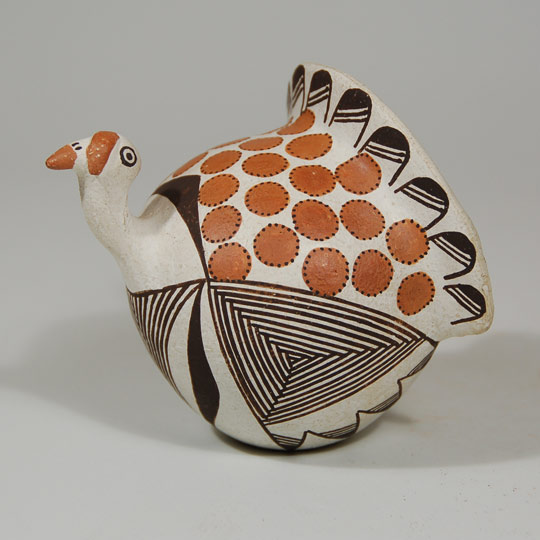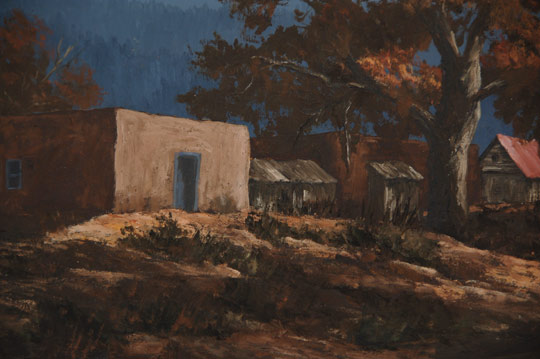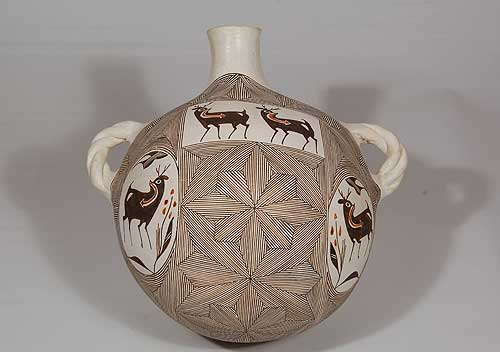Subject: Hopi Pueblo Mona Katsina Doll
According to Barton Wright, the Mona Katsina functions as the River or Thunder Katsina and appears singly in the Mixed Katsina Dances. His function seems to be simply that of encouraging the flow of water.
He appears most often on Third Mesa and there is the possibility that he may be limited to that mesa.
Condition: very good condition with the exception that the right foot has been broken and glued.
Provenance:
ex coll Mary Mira of Kansas City
ex coll Michael Frost Estate
Recommended Reading: Kachinas: a Hopi Artist's Documentary by Baron Wright
Subject: Hopi Pueblo Mona Katsina Doll
Carver Unknown
Category: Traditional
Origin: Hopi Pueblo
Medium: Cottonwood Root
Size: 8-1/2" tall
Item # C3360K
Biography: Martina Vigil (1856-1916) and Florentino Montoya (1858-1918)
As Jonathan Batkin has well documented, there were several outstanding potters at San Ildefonso during the 1890s whose work can fairly accurately be associated with their names. Following publication of Batkin's studies, it has become easier today to identify late 19th and early 20th century pottery to artists with some degree of accuracy, or so we hope. One husband and wife team, who were extraordinary artisans, was Martina Vigil and Florentino Montoya.
Martina and Florentino have been praised as among the finest artisans at San Ildefonso. Batkin has illustrated a couple of their works in his book Pottery of the Pueblos of New Mexico 1700-1940.
Subject: San Ildefonso Pueblo Polychrome Wedding Vessel
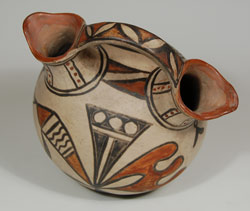 As Jonathan Batkin has well documented, there were several outstanding potters at San Ildefonso during the 1890s whose work can fairly accurately be associated with their names. Following publication of Batkin's studies, it has become easier today to identify late 19th and early 20th century pottery to artists with some degree of accuracy, or so we hope. One husband and wife team, who were extraordinary artisans, was Martina Vigil and Florentino Montoya.
As Jonathan Batkin has well documented, there were several outstanding potters at San Ildefonso during the 1890s whose work can fairly accurately be associated with their names. Following publication of Batkin's studies, it has become easier today to identify late 19th and early 20th century pottery to artists with some degree of accuracy, or so we hope. One husband and wife team, who were extraordinary artisans, was Martina Vigil and Florentino Montoya.
Martina and Florentino have been praised as among the finest artisans at San Ildefonso. Batkin has illustrated a couple of their works in his book Pottery of the Pueblos of New Mexico 1700-1940. It is based on photos in his book that one can identify pottery most likely made by them. This wedding vase is certainly their creation. The style and boldness of the design are quite comparable to those pictured in Batkin's book.
This wedding vessel contains rag-wiped Cochiti slip that was introduced to San Ildefonso by Martina and Florentino in the early 1900s, before they moved permanently to Cochiti around 1905. Most potters at San Ildefonso adopted the new slip immediately, but some continued using the old San Ildefonso slip that required stone polishing. This vessel dates to circa 1910.
Condition: very good condition
Provenance: the current owner purchased this vessel from Medicine Man Gallery in Santa Fe in 2004 and was provided a certificate attributing it to Martina and Florentino. The certificate accompanies the purchase.
Recommended Reading: Pottery of the Pueblos of New Mexico 1700-1940 by Jonathan Batkin
Subject: San Ildefonso Pueblo Polychrome Wedding Vessel
Artists / Potters: Martina Vigil (1856-1916) and Florentino Montoya (1858-1918)
Category: Historic
Origin: San Ildefonso Pueblo
Medium: clay, pigment
Size: 9" tall x 9" wide
Item # C3363C
Subject: Diné (Navajo) Sterling Silver and Turquoise Ring
This exquisite ring is comprised of a wide shank that is split into 3 legs at the top of the ring that support a curved silver base on which rests this beautiful blue round and domed turquoise stone. Four silver rivets rest at the edges of the silver platform. The ring was made from heavy silver stock, possibly ingot silver and probably dates from the 1940s decade. It is in excellent condition.
Subject: Diné (Navajo) Sterling Silver and Turquoise Ring
Jeweler Unknown
Category: Rings
Origin: Diné - Navajo Nation
Medium: Sterling Silver, Turquoise
Size: Ring 5-1/4; 5/8" x 5/8" face
Item # 25273
Subject: Diné (Navajo) Handmade Silver Buttons
It is documented that the Navajo made and wore silver buttons as early as 1824 and there are illustrations of this as early as 1840. The Navajo adopted this adornment from the Mexican, who had adopted it from the Spaniard.
Navajo men put buttons on trousers, jackets, moccasins, belts, pistol belts, gun scabbards, saddles, bridles, leather pouches, pouch straps and bow guards. Women used them as buttons on blouses and decorations running down sleeves and around collars. There were occasions where a Navajo would take buttons off clothing and use it for purchases at the trading post.
The earliest and simplest buttons were small domed buttons made by pressing a disk of silver into a rounded depression gouged in a piece of hard wood or soft iron, Later, fluted and decorated buttons appeared.
We are presenting 15 different groups of silver buttons, each group containing a different number of buttons. They are being offered as group lots, as shown below.
An excellent presentation of Navajo silver buttons is presented in our referenced book.
Provenance: This collection of 255 silver buttons was put together by a resident of Gallup, New Mexico in the 1980s.
Subject: Diné (Navajo) Handmade Silver Buttons
Jeweler Unknown
Category: Buttons and Conchas
Origin: Diné - Navajo Nation
Medium: Silver
Size: Less than 1"
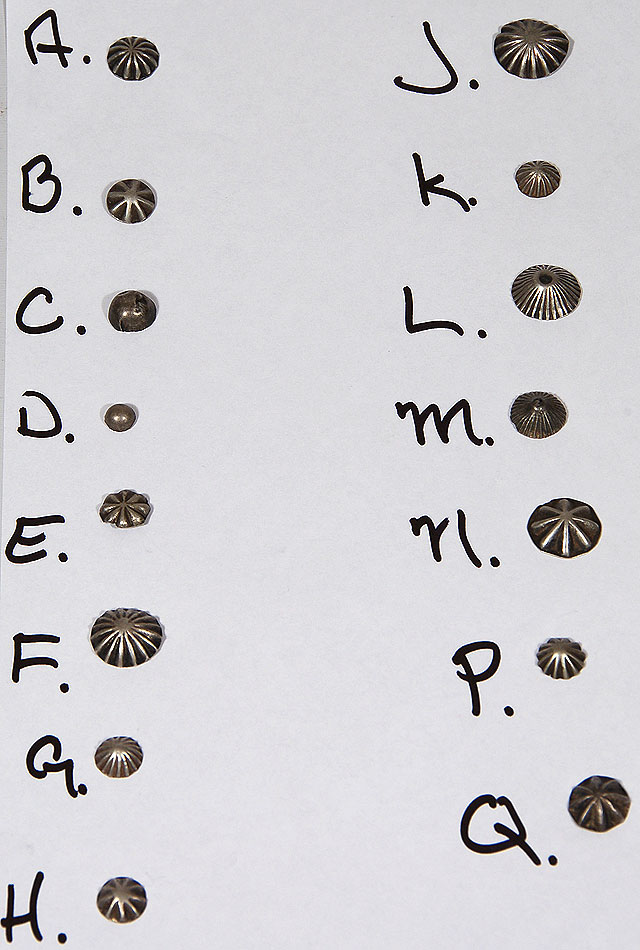
Subject: Historic Standing Male Figurine, Circa 1880
 Cochiti Pueblo figurines were at their prime between 1870 and 1920. They were most probably made in jest of non-Indian people: the Franciscan Monks, Spanish Merchants, Soldiers, Circus Freaks, etc. Unfortunately for today's collectors, the museum staffs shunned them. Not a single figurine was collected by the Indian Arts Fund from its founding in 1920 until after 1935.
Cochiti Pueblo figurines were at their prime between 1870 and 1920. They were most probably made in jest of non-Indian people: the Franciscan Monks, Spanish Merchants, Soldiers, Circus Freaks, etc. Unfortunately for today's collectors, the museum staffs shunned them. Not a single figurine was collected by the Indian Arts Fund from its founding in 1920 until after 1935.
Potters were discouraged from making them. The museum staffs thought they were grotesque and not fit for museum collections. Now, we find them charming, and today's collectors understand the humor and meaning of them. Had the potters been encouraged to make them, they would not be so rare today.
There are very few pieces available for collectors to purchase. We are fortunate to have acquired this one. We received the following letter in 2004 when we first acquired the figurine. It is from the great grandson of the original owner:
I have attached a photo of my Great Grandfather [see below]. He is posing with his wife, Mary (Finney) Morton, my grandfather on the left (Carl Willison Morton) and his son (James Ralph Morton). His name was William Walker Morton II. The photo was taken in 1887 in Washington, PA. He was living in Upper Buffalo, PA at the time.
He was a Presbyterian Minister and did extensive traveling throughout the US from the 1880s to the early 1900s. He was born on June 27, 1846 and died on March 1, 1927.
The figurine was made for him in his likeness. I understand he wore the minister's frock on his travels.
-Don Morton
When we first acquired this figurine from Don Morton in 2004, we asked Indian dealer and noted collector of Cochiti figurines to comment on this one for us. His comments are:
The 11-1/2" Cochiti figurine is a classic figure from the 1880s to 1900. Although they were still being made as late as the late teens, I believe this figure to be earlier. For a comparison, please see page 66 of the Clay People book. I believe this figure to be made by the same potter that made those pictured, as well as, the ones in the 1903 photo by Mr. George Pepper. This is a fine and rare example offered at a fair price.
-Bob Gallegos
Condition: excellent condition
Provenance: from the collection of the family of William Walker Morton II, descended through the family to his great grandson, Don Morton, from whom this was acquired.
Recommended Reading: Clay People: Pueblo Indian Figurative Traditions by Jonathan Batkin
Subject: Historic Standing Male Figurine, Circa 1880
Potter Unknown
Category: Figurines
Origin: Cochiti Pueblo
Medium: Native Materials
Size: 11-1/4" tall
Item # C3363A
![Carl Willison Morton I have attached a photo of my Great Grandfather [see below]. He is posing with his wife, Mary (Finney) Morton, my grandfather on the left (Carl Willison Morton) and his son (James Ralph Morton). His name was William Walker Morton II. The photo was taken in 1887 in Washington, PA. He was living in Upper Buffalo, PA at the time. He was a Presbyterian Minister and did extensive traveling throughout the US from the 1880s to the early 1900s. He was born on June 27, 1846 and died on March 1, 1927. The figurine was made for him in his likeness. I understand he wore the minister's frock on his travels. -Don Morton](https://www.adobegallery.com/uploads/C3363A-extra1.jpg)
Subject: Santa Clara Pueblo Black Carved Wedding Vessel
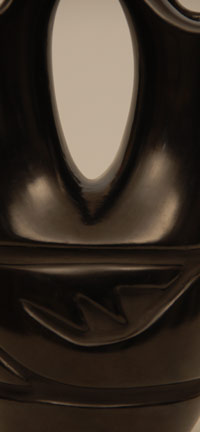 Florence Browning is one of five sisters, all of whom are recognized as outstanding potters. Her sisters are Clara Shije, Reycita Naranjo, Mary Singer and Elizabeth Naranjo and their mother was Pablita Chavarria-a family famous for blackware pottery.
Florence Browning is one of five sisters, all of whom are recognized as outstanding potters. Her sisters are Clara Shije, Reycita Naranjo, Mary Singer and Elizabeth Naranjo and their mother was Pablita Chavarria-a family famous for blackware pottery.
Florence worked for many years at the Indian Health Service during which time she was unable to produce much pottery. It was only after she retired that she became well-known as a potter. She also demonstrated pottery making in summers at Bandelier National Park. She is published in the catalog of the exhibit One Space/Three Visions, a major tri-cultural exhibit at the Albuquerque Museum in Albuquerque in 1979, and also published in Fourteen Families in Pueblo Pottery by Rick Dillingham.
This wedding vessel is very typical of the fine quality of her work. The construction was meticulously accomplished and the carving of the Avanyu design is clean and precise. The burnishing is almost mirror-like. It is an excellent vessel.
Condition: original condition
Provenance: from the personal collection of Paul and Dorothy Gutierrez of Santa Clara Pueblo
Recommended Reading: Fourteen Families in Pueblo Pottery by Rick Dillingham
Subject: Santa Clara Pueblo Black Carved Wedding Vessel
Artist / Potter: Florence Chavarria Browning (1931-present)
Category: Contemporary
Origin: Santa Clara Pueblo
Medium: clay
Size: 8-7/8" tall x 7-3/8" wide
Item # 25611
Subject: Santa Clara Pueblo Tan and Red Carved Plate
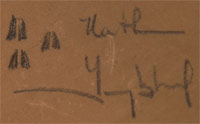 Nathan Youngblood is the grandson of Margaret Tafoya and son of Mela Youngblood. His sister is Nancy Youngblood. Nathan performs many public services as well as finding time to make exquisite pottery. For a more detailed biography of him, take a look on our website by clicking on his name above.
Nathan Youngblood is the grandson of Margaret Tafoya and son of Mela Youngblood. His sister is Nancy Youngblood. Nathan performs many public services as well as finding time to make exquisite pottery. For a more detailed biography of him, take a look on our website by clicking on his name above.
Youngblood is known for his creative designs and technical precision. His burnishing is very fine and he finely sands the edges of his carved designs. He often combines redware with buffware, as in this plate.
He created a stylized Avanyu circling around a buff circle in the center of the plate and placed a raised buff border to frame the design. The cream/tan background is matte finish and the remainder is stone polished.
Condition: original condition
Provenance: from the estate of a collector from Colorado
Recommended Reading: Pueblo Indian Pottery: 750 Artist Biographies by Gregory Schaaf
Artist: Nathan Youngblood (1954-present) Deer Path
Category: Contemporary
Origin: Santa Clara Pueblo
Medium: clay, pigment
Size: 8-1/2" diameter x 1" deep
Item # C3356B
Biography: Nathan Youngblood (1954- ) Deer Path
 Nathan Youngblood is known for his contributions to public service. He has sat on the Board of Directors of the Wheelwright Museum in Santa Fe and volunteered his time at the annual Wheelwright auction. He has also served on the boards for the Gallup Inter-tribal Indian Ceremonial and the Southwestern Association on Indian Arts (SWAIA), the producer of Santa Fe Indian Market. He has been a board member of the American Crafts Council in New York, on the advisory board for the Scottsdale Center for the Arts and the School for Advanced Research in Santa Fe. He has lectured at the National Museum of American Art in Washington, D.C., the Denver Museum of Natural History, and Museum of Indian Arts and Culture in Santa Fe as well as numerous other venues.
Nathan Youngblood is known for his contributions to public service. He has sat on the Board of Directors of the Wheelwright Museum in Santa Fe and volunteered his time at the annual Wheelwright auction. He has also served on the boards for the Gallup Inter-tribal Indian Ceremonial and the Southwestern Association on Indian Arts (SWAIA), the producer of Santa Fe Indian Market. He has been a board member of the American Crafts Council in New York, on the advisory board for the Scottsdale Center for the Arts and the School for Advanced Research in Santa Fe. He has lectured at the National Museum of American Art in Washington, D.C., the Denver Museum of Natural History, and Museum of Indian Arts and Culture in Santa Fe as well as numerous other venues.
With all this public service, Youngblood finds time to make exquisite pottery in the tradition of his famous Tafoya family. He is the grandson of Margaret Tafoya and son of Mela Youngblood. His sister is Nancy Youngblood. Youngblood is known for his creative designs and technical precision. His burnishing is very fine and he finely sands the edges of his carved designs. Like his grandmother, he believes in the importance of traditional firing one pot at a time, thus greatly diminishing the chance of damage to pottery that may have taken 300 to 400 hours of preparation.
Subject: Santa Clara Polished Black Melon Jar
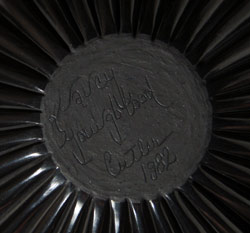 There is probably no one who does not know who Nancy Youngblood is but, if that is not the case, then here is a short introduction to her. She is the granddaughter of Margaret Tafoya and daughter of Mela Youngblood. She is a master crafts person and certainly one of the most famous younger potters of today. Nancy is known for her patience in making the most precise and perfect pottery. She spares no effort in producing the perfect pot. For more information on her, check the more detailed biography on our website by clicking on her name above.
There is probably no one who does not know who Nancy Youngblood is but, if that is not the case, then here is a short introduction to her. She is the granddaughter of Margaret Tafoya and daughter of Mela Youngblood. She is a master crafts person and certainly one of the most famous younger potters of today. Nancy is known for her patience in making the most precise and perfect pottery. She spares no effort in producing the perfect pot. For more information on her, check the more detailed biography on our website by clicking on her name above.
This melon jar, with 32 ribs, is typical of the intense amount of work she puts into each creation. Each of these ribs is polished on both sides, leaving the valley between parallel ribs in the matte state. Each rib was polished to a beautiful sheen and the firing of the pot was perfect.
Condition: the jar is in original condition with the exception of a very minor abrasion on one rib.
Provenance: from the estate of a collector from Colorado
Recommended Reading: Pueblo Indian Pottery: 750 Artist Biographies by Gregory Schaaf
Subject: Santa Clara Polished Black Melon Jar
Artist / Potter: Nancy Youngblood (1955-present) Yellow Aspen
Category: Contemporary
Origin: Santa Clara Pueblo
Medium: clay
Size: 3-1/4" tall x 3-7/8" diameter
Item # C3356A
Biography: Nancy Youngblood (1955- ) Yellow Aspen
 Nancy Youngblood is the granddaughter of Margaret Tafoya and daughter of Mela Youngblood. She is a master crafts person and certainly one of the most famous younger potters of today. Nancy is known for her patience in making the most precise and perfect pottery. She spares no effort in producing the perfect pot.
Nancy Youngblood is the granddaughter of Margaret Tafoya and daughter of Mela Youngblood. She is a master crafts person and certainly one of the most famous younger potters of today. Nancy is known for her patience in making the most precise and perfect pottery. She spares no effort in producing the perfect pot.
As a child, her military father gave the family a cosmopolitan background by traveling through Europe and living in The Netherlands. At age 12, she returned to the pueblo where she began to watch her grandmother's work. This was her primary tutorial in what was to become her calling-traditional Santa Clara Pueblo Pottery-but of the highest quality.
Youngblood fires each piece in the traditional way using an open pit that resembles that of a campfire. Early on, she would fire outside, being vulnerable to wind and rain, elements that dictate how successful a firing will be. To overcome this hazard, Youngblood designed and built her own enclosed firing house at the pueblo making weather concerns minimal, yet still keeping with tradition.
After preparing, polishing and carving a piece-which could take from 50 to 300 hours-in this final process there is always the chance that the item will crack and sometimes explode in the fire. There are no gauges to use in determining when a pot is ready to remove from the firing process.
Youngblood has received several hundred awards for her pottery at all the major venues where artist compete. Her pottery has been exhibited in major galleries and museums and she has been published in books and articles.
Subject: Hopi Large Polychrome Storage Jar with Fluted Rim
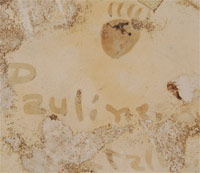 Pauline Setalla was born and raised on the Second Mesa village of Mishongnovi. When she married Justin Setalla they moved to his ranch in Snowbird Canyon which is approximately 3 miles from Keams Canyon on the reservation. Their home was a traditional Hopi adobe home that had been built by Justin and his dad Roscoe. It had no modern conveniences of today's standards. Light was provided by kerosene and Coleman lantern and heat by wood and coal in a stove. Drinking water had to be hauled from the family well. Under these conditions, Pauline Setalla mastered the techniques of pottery production.
Pauline Setalla was born and raised on the Second Mesa village of Mishongnovi. When she married Justin Setalla they moved to his ranch in Snowbird Canyon which is approximately 3 miles from Keams Canyon on the reservation. Their home was a traditional Hopi adobe home that had been built by Justin and his dad Roscoe. It had no modern conveniences of today's standards. Light was provided by kerosene and Coleman lantern and heat by wood and coal in a stove. Drinking water had to be hauled from the family well. Under these conditions, Pauline Setalla mastered the techniques of pottery production.
Her pottery is noted for its strong, bold designs, excellent painting quality, stippled shading and beautiful clay that fires in warm shades from yellow to orange. Her forms are well balanced and elegant in shape. The symmetry reflects technical skill and confidence. Her designs are bolder than often seen on Hopi pottery by other potters. Her work is immediately recognizable.
The large storage jar is typical of her outstanding workmanship. It is beautifully proportioned and skillfully constructed. The rim rolls out in undulating ripples which the potter accented by painting it a rusty red. The body design includes the face of a Long Hair Katsina and ears of corn. To the Hopi, corn is not only the traditional staff of life but also the symbol of spiritual food and welfare.
This jar is a perfect complement to a pair of large cylinder jar made by Setalla at the same time. The three pieces have been together for about 40 or 50 years and deserved to continue their relationship, however, we must, of course, sell them separately if that is the desire of the purchaser.
Condition: structurally in original condition with some minor over-paint on brown color.
Provenance: from the collection of Katherine H. Rust whose collection was mostly amassed in the 1960s and 1970s so it is assumed that is the approximate period that these were made.
Recommended Reading: Hopi-Tewa Pottery: 500 Artist Biographies by Gregory and Angie Schaaf
Subject: Hopi Large Polychrome Storage Jar with Fluted Rim
Artist / Potter: Pauline Setalla (1930-?)
Category: Contemporary
Origin: Hopi Pueblo
Medium: clay, pigment
Size: 9-3/8" tall x 12-1/4" diameter
Item # C3309K
Subject: Pair of Hopi Polychrome Cylindrical Jars
Pauline Setalla married into the Frog Woman/Feather Woman family clan. It was reported by her son several years ago that she was in ill health and retired from making pottery. We have not had an update on her health since that time. She had 10 children, some of whom are potters carrying on her legacy. She was raised on the Second Mesa village of Mishongnovi on the Hopi Reservation. She learned pottery production techniques from her mother-in-law, Agnes Navasie, and her sister-in-law, Eunice Navasie.
 All of Setalla's pottery was formed in the traditional coil technique from native clay and slipped with vegetal paints and painted in the traditional manner. Firing was with sheep dung, a popular way at Hopi. This pair of Hopi cylinders was made in that manner.
All of Setalla's pottery was formed in the traditional coil technique from native clay and slipped with vegetal paints and painted in the traditional manner. Firing was with sheep dung, a popular way at Hopi. This pair of Hopi cylinders was made in that manner.
We are presenting this pair of cylinders together; however, they may be purchased separately. Both feature the face of a Long Hair Katsina in opposing panels of decoration and one of the cylinders features a bowl of corn and a turtle image and the other cylinder features a large frog image on opposing panels. They make a wonderful pair should someone want both. They are the same size and style and are complimentary to each other.
Condition: structurally in original condition with some minor over-paint on brown color.
Provenance: from the collection of Katherine H. Rust whose collection was mostly amassed in the 1960s and 1970s so it is assumed that is the approximate period that these were made.
Recommended Reading: Hopi-Tewa Pottery: 500 Artist Biographies by Gregory and Angie Schaaf
Subject: Pair of Hopi Polychrome Cylindrical Jars
Artist / Potter: Pauline Setalla (1930-?)
Category: Contemporary
Origin: Hopi Pueblo
Medium: clay, pigment
Size: 11-3/4" tall x 7-1/4" diameter
Item # C3309H-J
Subject: Acoma Pueblo Polychrome Turkey Figurine by Lucy Lewis
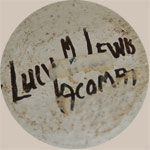 Travelers to New Mexico who have been to Acoma Pueblo are familiar with the original village atop the mesa known today as Sky City. It was on top of that mesa in 1898 that Lucy Martin Lewis was born and it was there that she grew up without the benefit of going to school. It was there also that she was struck by lightning in the 1960s. There was little hope that she would ever work again, but with perseverance she regained her muscle strength and went on to become one of the most recognized potters at Acoma Pueblo.
Travelers to New Mexico who have been to Acoma Pueblo are familiar with the original village atop the mesa known today as Sky City. It was on top of that mesa in 1898 that Lucy Martin Lewis was born and it was there that she grew up without the benefit of going to school. It was there also that she was struck by lightning in the 1960s. There was little hope that she would ever work again, but with perseverance she regained her muscle strength and went on to become one of the most recognized potters at Acoma Pueblo.
Turkey figurines seem to be a popular art form for potters of New Mexico pueblos, perhaps because there is a large population of wild turkeys in the state. Most potters who make figurines include turkeys in the repertoire. This one is signed Lucy M. Lewis Acoma. Earlier, there was a time when she did not sign her pottery, identifying them only by their place of origin: Acoma, N. M. or Sky City, N. M. At that time, Lucy sold her pots from a roadside stand on Route 66 for as little as a dollar or two. Today, they command significantly more.
This turkey is an earlier one by Lewis, not as early as the 1960s but early enough that she was painting exquisitely. Look at the red circles on the back of the turkey and notice that each circle is outlined in small black dots. Notice also the precision with which the parallel black lines were executed. This is an exceptional figurine.
Condition: original condition
Provenance: from a family living in Illinois
Recommended Reading: Fourteen Families in Pueblo Pottery by Rick Dillingham
Subject: Acoma Pueblo Polychrome Turkey Figurine by Lucy Lewis
Artist / Potter: Lucy Martin Lewis (1898-1992)
Category: Figurines
Origin: Acoma Pueblo
Medium: clay, pigment
Size: 3-3/4" tall x 4" wide
Item # C3359A
Biography: Lucy Martin Lewis (1898-1992)
 Lucy Martin Lewis passed away on March 12, 1992 at a supposed age of 93. Her year of birth is not known. She spent nearly all her life atop the high mesa of Acoma Pueblo, making pottery since the age of 7. She is largely responsible for the revival of Mimbres black-on-white pottery designs which are more than 1,000 years old. She was famous, as well, for her exquisite polychrome designs and her fine-line and lightning designs.
Lucy Martin Lewis passed away on March 12, 1992 at a supposed age of 93. Her year of birth is not known. She spent nearly all her life atop the high mesa of Acoma Pueblo, making pottery since the age of 7. She is largely responsible for the revival of Mimbres black-on-white pottery designs which are more than 1,000 years old. She was famous, as well, for her exquisite polychrome designs and her fine-line and lightning designs.
Lucy Lewis was one of the most widely respected potters from her pueblo. She was the last of the Acoma matriarchs. She followed pueblo tradition in every step of pottery production-offering prayers of thanks to Mother Earth for the clay, taking only as much clay as she needed, working the clay with only her hands, forming the vessel from coils of clay, scraping the walls with tools fashioned from gourds, painting the vessel with slips and paints made from clay and vegetal sources and, finally, firing the finished pieces in an outdoor handmade kiln. Lucy signs her potter as Lucy M. Lewis.
Title: Original Oil Painting “Cottonwood with Adobes” by Betty Sabo
Betty Sabo is one of Albuquerque's most famous contemporary artists. She was a student at some point of Carl Von Hassler, probably in the early years of her career. She was best known as a painter until later in her career at which time she switched to sculpture. Her paintings were so popular they were snatched up before the paint dried.
She studied art at UNM in the late 1940s and was a renowned painter before she began to create the signature bronzes in her mid-60s. The Albuquerque Museum commissioned one of her first pieces; the 1995 bronze "Julia Resting," of a woman seated on a bench outside the museum's front doors. She also sculpted the Botanical Garden work featuring Clyde and Carrie Tingley, neighbors of Sabo's when she was a child. Clyde Tingley was an early Governor of New Mexico.
Paintings by Sabo are relatively rare as those who knew her when she was a painter have tended to keep those they purchased. It has been a number of years since she painted, so there are no recent ones for collectors to purchase and there will be no more as Sabo is living with Alzheimers.
Sabo's legacy, other than the fine art she produced, will be her determination in 1986 to acquire for the Albuquerque Museum the large quantity of fine art amassed at her alma mater, Albuquerque High School. Graduating classes had developed the routine of purchasing a painting for the school at graduation each year. The school collection contained paintings by Oscar Berninghaus, Ernest Blumenschein, Bert Phillips and Carl Redin. A Santa Fe gallery was attempting to purchase the collection but Sabo was determined it should stay in Albuquerque. She succeeded and that collection now resides permanently at the museum.
This Sabo painting is clear evidence of Sabo's artistic talent in rendering New Mexico as New Mexican see it on a regular basis. The dark sky is typical of fall storms approaching, rolling over the mountains and heading toward the ranchito. The sun is still shining on the buildings but will disappear shortly to the effect of the storm. Sabo was just the best at depicting such a scene. This painting is not dated but is certainly prior to 1990.
Condition: This painting is in original excellent condition. It is signed Sabo in lower left. Although there is nothing structurally wrong with the frame, I think it is too distracting from the fine art work and I suggest a simpler frame would be better.
Provenance: from the collection of a resident of Arizona
Recommended Reading: The book, The New Mexico Experience: 1598-1998 by University of New Mexico President Richard E. Peck is a wonderful brief history of New Mexico that is highly recommended for anyone interested in any aspect of the state (history, science, art, culture).
Title: Original Oil Painting "Cottonwood with Adobes"
Artist: Betty Sabo (1928 - present)
Category: Paintings
Origin: European-American Artists
Medium: oil on board
Size: 11-5/8" x 15-5/8" image; 20-1/2" x 24-1/2" framed
Item # C3358
Biography: Betty Sabo (1928- )
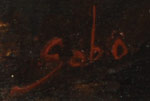 Betty Jean Sabo is one of Albuquerque's most famous contemporary artists. She was a student at some point of Carl Von Hassler, probably in the early years of her career. She was best known as a painter until later in her career at which time she switched to sculpture.
Betty Jean Sabo is one of Albuquerque's most famous contemporary artists. She was a student at some point of Carl Von Hassler, probably in the early years of her career. She was best known as a painter until later in her career at which time she switched to sculpture.
She studied art at UNM in the late 1940s and was a renowned painter before she began to create the signature bronzes in her mid-60s. The Albuquerque Museum commissioned one of her first bronze pieces; the 1995 bronze "Julia Resting," of a woman seated on a bench outside the museum's front doors. She also sculpted the Botanical Garden work featuring Clyde and Carrie Tingley, neighbors of Sabo's when she was a child. Clyde Tingley was an early Governor of New Mexico.
Paintings by Sabo are relatively rare as those who knew her when she was a painter have tended to keep those they purchased. It has been a number of years since she painted, so there are no recent ones for collectors to purchase.
Subject: Acoma Pueblo Large Canteen by Rose Chino Garcia
Rose Chino Garcia and her sisters, Carrie Chino Charlie, Vera Chino Ely and Grace Chino, are daughters of Marie Z. Chino and all of them are exceptional potters, as was their mother. Garcia's pottery is in the collections of the Peabody Museum at Harvard University, Heard Museum in Phoenix, Philbrook Museum of Art in Tulsa, and numerous private collections. She has won awards at Santa Fe Indian Market since 1975-one award was for "most creative design."
Rose Chino Garcia is an exceptional potter, achieving beautifully thin-walled vessels and well-balanced designs. The design on this canteen is the purest fine-line design any artist could achieve. Each line, placed free-hand, is parallel to the next with separations of equal space between all of them. The star-burst at the center of the body is a perfect design to capture one's attention. The added heartline deer elements are one of her favorite designs.
The condition of the canteen is excellent. There are about three minute spall marks that are hard to find and certainly do not detract from the beauty of the canteen.
Subject: Acoma Pueblo Large Canteen by Rose Chino Garcia
Artist / Potter: Rose Chino Garcia (b. 1928)
Category: Contemporary
Origin: Acoma Pueblo
Medium: Native materials
Size: 10" tall x 8" diameter
Item # C3107D
Biography: Burel Naha
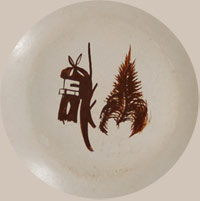 Burel Naha is the son of Helen Naha (Feather Woman) and grandson of Paqua Naha (Frog Woman) and brother of Rainy Naha and Sylvia Naha. Burel and his sisters continued the tradition of their famous mother in producing pottery of the finest quality and with superb design creations. He signs his pottery with a Feather and Longhair Katsina Hallmark.
Burel Naha is the son of Helen Naha (Feather Woman) and grandson of Paqua Naha (Frog Woman) and brother of Rainy Naha and Sylvia Naha. Burel and his sisters continued the tradition of their famous mother in producing pottery of the finest quality and with superb design creations. He signs his pottery with a Feather and Longhair Katsina Hallmark.
Burel specializes in traditional Hopi pottery but has created his own unique style. He enjoys painting spiders with intricate web designs all around his pottery. The earlier designs that he used were of the style of his mother's.
Burel received his BA at Brigham Young University. He was a teacher for many years and now has dedicated his life to the traditional ways of his Hopi ancestors. Burel credits his success to his mother for teaching him the traditional ways of their ancestors.
He has received awards from the New Mexico State Fair and the Gallup Inter-tribal Indian Ceremonial.
-Biography from Artists in Clay: The Winona Sate University Collection of Southwest Native American Pottery
Biography: Tony Abeyta (1965- )
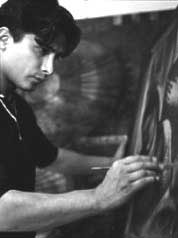 Educated at Santa Fe's Institute of American Indian Art, the Maryland Institute's College of Art in Baltimore, and then overseas in Southern France and Florence, Italy, Tony Abeyta, a graduate of the Maryland Institute, returned to school taking postgraduate classes in art and filmmaking at the Chicago Art Institute on a Ford Foundation scholarship.
Educated at Santa Fe's Institute of American Indian Art, the Maryland Institute's College of Art in Baltimore, and then overseas in Southern France and Florence, Italy, Tony Abeyta, a graduate of the Maryland Institute, returned to school taking postgraduate classes in art and filmmaking at the Chicago Art Institute on a Ford Foundation scholarship.
Abeyta uses the bold colors representative of his homeland and finds his medium of painting involving sand, acrylic, and oil paint, gold leafing and encaustic wax and collage elements to achieve the desired results of his work.
I use many different techniques, mediums and processes to reinforce my ideas. Although I have studied sculpture, drawing and printmaking, I choose painting as my means of translating these ideas as well as my spiritual self onto the canvas.
Abeyta works with vast fields of color and texture one might find in Indian crosses, early Navajo (Diné) blanket designs, as well as prehistoric sensibilities of Indian design and earth toned color. Abeyta's work has predominantly focused on Native American deities such as the Navajo (Diné) Yei-be-chai and Kachinas. He shows the importance of these images in Native American religion and culture without literally depicting them.
I want my work to reinforce the ideology of Indian religion, its strength, its beauty and semblance. I work to create an interpretation of these deities translated through myself and given an identity devoid of their actual documented existence. I'm more interested in an icon or the idea, which these beings represent. This system of ritual belief is the most important basis in Indian culture and insures its infinite existence.
Abeyta makes a living from his artwork, which also deals in American Indian images. Early recognition has allowed him to devote his time to what he loves best. Abeyta is an excellent example of the contemporary Southwestern Indian artist whose struggles for success have differed dramatically from predecessors.
Considered to be one of the finest contemporary painters today, artist Tony Abeyta, Navajo painter and jewelry designer, has been honored as a living treasure as part of the 2012 Native Treasures Indian Arts Festival-artists specially invited by the Museum of Indian Arts and Culture.


